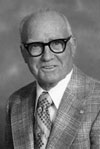About the Donor
 George Herman Starr
George Herman StarrDr. George Herman Starr died on November 13, 1982, after a hard-fought battle with cancer. He succumbed at the hospital near his retirment home in Fort Collins, CO.
He was born on a farm near Bismarck, IL, but moved to Lane, SD, when he was a small boy. He attended high school in Mitchell, SD, and completed courses in 1918. After high school, he attended South Dakota State College and graduated with a B.S. degree in 1925 with a major in agronomy and a minor in horticulture. In the summers, he worked for the USDA early in its barberry eradication program.
Starr married Meriel Louise Spooner, with whom he became acquainted because they were alphabetically seated at the daily convocation in college. Both taught school for a few years before Starr returned to school with his wife’s support and completed his M.S. degree in l928 at the University of Nebraska in Lincoln with a major in horticulture and a minor in botany. His Ph.D. degree in plant pathology was completed in 1931 at the University of Minnesota under the guidance of J. G. Leach.
After graduation, Starr accepted a plant pathology teaching, research, and extension position at the University of Wyoming at Laramie. For many years, he was the only plant pathologist at the university. He authored publications in plant pathology and agriculture, and many of these were on potato and bean diseases. Starr led the program for producing blight-free bean seed during World War II, when many acres of snap bean seed were grown in Wyoming.
During his active years as a plant pathologist, Starr stimulated the scientific and teaching careers of many plant pathologists by exhibiting exceptional enthusiasm for the discipline as he supervised their graduate training.
In 1952, Starr accepted an invitation to be the director of agricultural extension for the university and the state of Wyoming. He continued to be an active plant pathologist, filling in wherever he was most needed both locally at the University of Wyoming and nationally.
He retired in 1964, after 33 years of service to the university, state, and nation. We will long remember George, not for the honors he received, which were many, or even his exceptional service to others, but for his friend friendliness to everyone, his philosophy of life, and his personal integrity. We knew him, loved him, and were inspired by him. The memories did not and will not pass away.
Colleagues and friends established this fund in honor and memory of George Herman Starr for the contributions he made to the science of plant pathology through his research, teaching, and service. The first travel award was given at the 2007 Annual Meeting in San Diego, CA.
